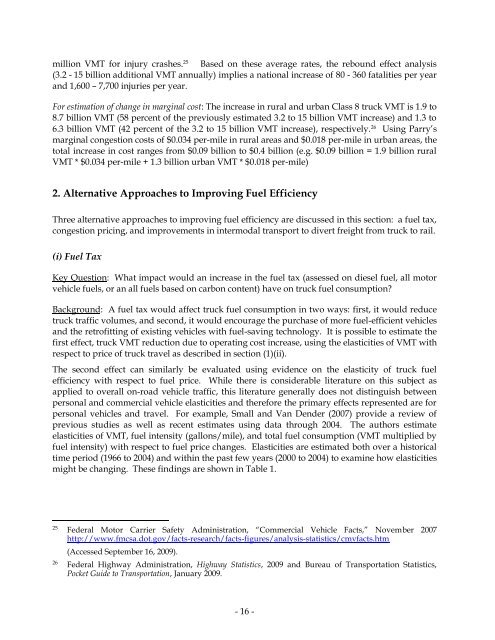Assessment of Fuel Economy Technologies for Medium and Heavy ...
Assessment of Fuel Economy Technologies for Medium and Heavy ...
Assessment of Fuel Economy Technologies for Medium and Heavy ...
Create successful ePaper yourself
Turn your PDF publications into a flip-book with our unique Google optimized e-Paper software.
million VMT <strong>for</strong> injury crashes. 25 Based on these average rates, the rebound effect analysis<br />
(3.2 - 15 billion additional VMT annually) implies a national increase <strong>of</strong> 80 - 360 fatalities per year<br />
<strong>and</strong> 1,600 – 7,700 injuries per year.<br />
For estimation <strong>of</strong> change in marginal cost: The increase in rural <strong>and</strong> urban Class 8 truck VMT is 1.9 to<br />
8.7 billion VMT (58 percent <strong>of</strong> the previously estimated 3.2 to 15 billion VMT increase) <strong>and</strong> 1.3 to<br />
6.3 billion VMT (42 percent <strong>of</strong> the 3.2 to 15 billion VMT increase), respectively. 26 Using Parry‘s<br />
marginal congestion costs <strong>of</strong> $0.034 per-mile in rural areas <strong>and</strong> $0.018 per-mile in urban areas, the<br />
total increase in cost ranges from $0.09 billion to $0.4 billion (e.g. $0.09 billion = 1.9 billion rural<br />
VMT * $0.034 per-mile + 1.3 billion urban VMT * $0.018 per-mile)<br />
2. Alternative Approaches to Improving <strong>Fuel</strong> Efficiency<br />
Three alternative approaches to improving fuel efficiency are discussed in this section: a fuel tax,<br />
congestion pricing, <strong>and</strong> improvements in intermodal transport to divert freight from truck to rail.<br />
(i) <strong>Fuel</strong> Tax<br />
Key Question: What impact would an increase in the fuel tax (assessed on diesel fuel, all motor<br />
vehicle fuels, or an all fuels based on carbon content) have on truck fuel consumption<br />
Background: A fuel tax would affect truck fuel consumption in two ways: first, it would reduce<br />
truck traffic volumes, <strong>and</strong> second, it would encourage the purchase <strong>of</strong> more fuel-efficient vehicles<br />
<strong>and</strong> the retr<strong>of</strong>itting <strong>of</strong> existing vehicles with fuel-saving technology. It is possible to estimate the<br />
first effect, truck VMT reduction due to operating cost increase, using the elasticities <strong>of</strong> VMT with<br />
respect to price <strong>of</strong> truck travel as described in section (1)(ii).<br />
The second effect can similarly be evaluated using evidence on the elasticity <strong>of</strong> truck fuel<br />
efficiency with respect to fuel price. While there is considerable literature on this subject as<br />
applied to overall on-road vehicle traffic, this literature generally does not distinguish between<br />
personal <strong>and</strong> commercial vehicle elasticities <strong>and</strong> there<strong>for</strong>e the primary effects represented are <strong>for</strong><br />
personal vehicles <strong>and</strong> travel. For example, Small <strong>and</strong> Van Dender (2007) provide a review <strong>of</strong><br />
previous studies as well as recent estimates using data through 2004. The authors estimate<br />
elasticities <strong>of</strong> VMT, fuel intensity (gallons/mile), <strong>and</strong> total fuel consumption (VMT multiplied by<br />
fuel intensity) with respect to fuel price changes. Elasticities are estimated both over a historical<br />
time period (1966 to 2004) <strong>and</strong> within the past few years (2000 to 2004) to examine how elasticities<br />
might be changing. These findings are shown in Table 1.<br />
25<br />
Federal Motor Carrier Safety Administration, ―Commercial Vehicle Facts,‖ November 2007<br />
http://www.fmcsa.dot.gov/facts-research/facts-figures/analysis-statistics/cmvfacts.htm<br />
(Accessed September 16, 2009).<br />
26<br />
Federal Highway Administration, Highway Statistics, 2009 <strong>and</strong> Bureau <strong>of</strong> Transportation Statistics,<br />
Pocket Guide to Transportation, January 2009.<br />
- 16 -
















